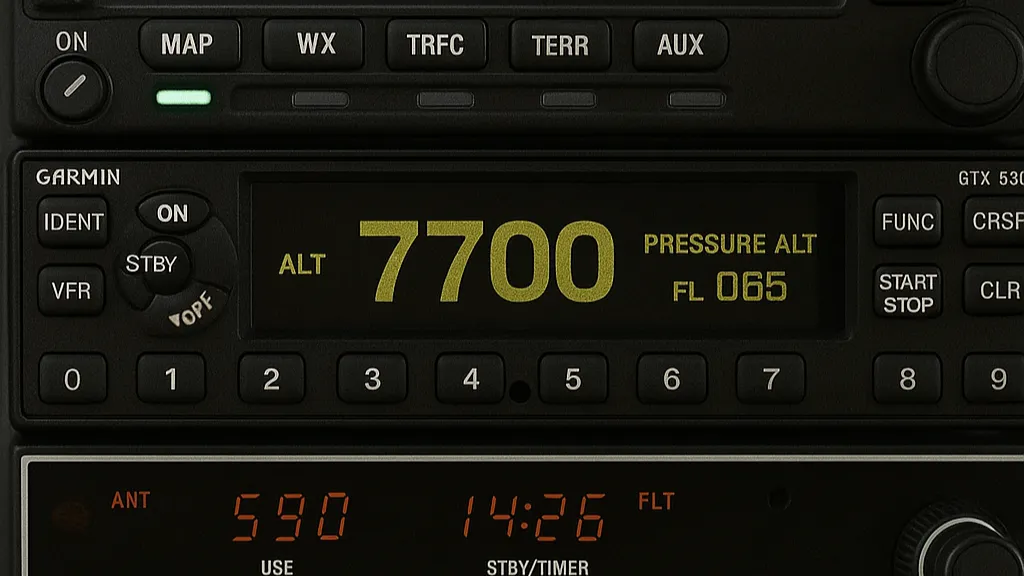In the world of aviation, clear communication saves lives. An aircraft’s transponder plays a critical role in that communication, constantly transmitting a stream of vital information to air traffic control (ATC). This small device silently relays a plane’s position, altitude, and identity, allowing controllers to safely separate and guide countless aircraft through the sky. But when trouble strikes, one simple four-digit code cuts through the routine chatter: Squawk 7700.
What Is Squawk 7700?
Squawk 7700 is aviation’s universal emergency code. When a pilot dials these four digits into the aircraft’s transponder, it instantly signals an emergency to every radar screen monitoring that airspace. Unlike routine communications, which may take precious seconds, this code immediately prioritizes the flight for air traffic controllers, ensuring help is mobilized as fast as possible.
Whether it’s an engine failure, medical emergency, fire, or any serious issue, Squawk 7700 tells ATC one thing: the flight is in distress and requires immediate assistance.
Why Squawk 7700 Works So Well
Air traffic control is a constant stream of communication. Hundreds of aircraft, each with their own squawk code, fill controllers’ screens every minute. But when 7700 appears, it flashes like a digital flare. ATC systems automatically highlight the code, drawing immediate attention to the aircraft. Controllers quickly shift their focus to provide priority handling, redirect traffic, and coordinate emergency services if needed.
This speed matters. In a crisis, seconds can make the difference between a safe landing and catastrophe.
How a Transponder Talks to Air Traffic Control
Think of a transponder as the aircraft’s digital ID badge. Normally, each aircraft is assigned a unique squawk code (a four-digit identifier) for routine tracking. For example:
- 1200: Standard VFR (Visual Flight Rules) code in the U.S.
- 7500: Hijacking in progress.
- 7600: Radio communication failure.
- 7700: General emergency.
These codes allow controllers to immediately recognize the nature of the flight, its status, and any potential issues.
The Decision to Squawk 7700
Declaring an emergency isn’t a decision pilots take lightly. Training prepares them for a wide range of scenarios, but in real time, stress and uncertainty are always present. Some pilots hesitate, worried about consequences or believing they can handle the situation alone. However, delaying the decision to squawk 7700 can cost valuable time.
Consider a medical emergency, sudden engine failure, or severe turbulence. When a pilot activates Squawk 7700, it instantly mobilizes resources that might otherwise take critical minutes to coordinate.
Learn more about aeronautical decision making.
Inside the Cockpit: Responding to an Emergency
Once 7700 is entered, the cockpit shifts into high gear. The crew follows emergency checklists, communicates with ATC, and works together to stabilize the situation. Training ensures that even amid alarm bells and flashing warnings, pilots maintain a methodical approach.
While chaos may exist outside the aircraft, inside the cockpit, it becomes a controlled race against time.
Inside the Control Tower: How ATC Responds to Squawk 7700
When a 7700 code appears on the controller’s screen, a well-rehearsed protocol begins:
- Immediate Identification: The controller instantly identifies the aircraft and its position.
- Clearing the Airspace: Other aircraft are rerouted to give the distressed plane clear airspace.
- Contacting Emergency Services: Fire, medical, and rescue teams are notified and positioned.
- Continuous Communication: The controller provides the pilot with guidance, support, and updated instructions.
- Managing Remaining Traffic: Other flights continue safely with minimal disruption thanks to backup systems and multi-tasking controllers.
This process is seamless, thanks to years of training and international standardization.
Aviation Squawk Code Reference Table
| Squawk Code | Meaning | When Used | Priority Level |
|---|---|---|---|
| 1200 | VFR Flight | Routine Visual Flight | Low |
| 7500 | Hijacking | Security Threat | Highest |
| 7600 | Lost Communications | Radio Failure | High |
| 7700 | Emergency | Any Serious Emergency | High |
These codes help ATC triage and respond to unfolding situations in real time.
The Global Power of Squawk 7700
One of Squawk 7700’s greatest strengths is its universal meaning. Whether a plane declares an emergency over the Atlantic, the Himalayas, or over busy U.S. airspace, controllers worldwide recognize the code instantly. Thanks to the work of the International Civil Aviation Organization (ICAO), these standards are uniform across countries and languages.
ICAO ensures that:
- Procedures for responding to 7700 are consistent worldwide.
- Countries coordinate across borders for search and rescue operations.
- Emergency response remains fast, efficient, and safe, even in international airspace.
This global language of safety ensures that no matter where an emergency happens, help is coming.
Real-Life Stories of Squawk 7700 in Action
Behind every activation of Squawk 7700 is a human story. Here are just a few examples that illustrate its importance:
- Medical Emergency Mid-Flight: In 2021, a pilot suffered a heart attack while in flight. His co-pilot immediately squawked 7700, allowing ATC to clear a path for an emergency landing where medical teams were already waiting. The quick action likely saved the pilot’s life.
- Engine Failure Over the Rockies: A flight over the Rocky Mountains experienced engine failure at high altitude. Upon squawking 7700, controllers immediately diverted traffic, guided the crew to the nearest airport, and coordinated fire and rescue teams for a safe landing.
- Smoke in the Cabin: During descent, a smoke alarm indicated potential fire onboard. Though it was later determined to be a false alarm, the pilot wisely activated 7700. Emergency teams were standing by upon landing, ready to respond had the situation escalated.
These stories demonstrate that quick decisions combined with ATC’s rapid response often turn potentially catastrophic events into survivable ones.
The Simple Power of Four Digits
In aviation, every system is built with layers of safety, but Squawk 7700 remains one of the simplest, most effective tools available to pilots. It requires no verbal explanation, no long conversations, just four digits that speak volumes.
This single action triggers a chain of well-coordinated events designed to protect lives and ensure the safe resolution of emergencies. From cockpit to control tower to ground response, Squawk 7700 is a global symbol of aviation safety at work.
Recent Posts
FAA MOSAIC Final Rule: What Pilots, Manufacturers, and the Aviation Community Need to Know
Learn how the FAA’s MOSAIC final rule revolutionizes Light-Sport Aircraft certification, expands Sport Pilot privileges, and reshapes general aviation. See what’s changing, when it takes effect,...
Student Pilot Insurance: Essential Coverage for Aspiring Flyers
Discover how student pilot insurance can protect your flying dreams. Get expert tips and coverage options to ensure your safety and peace of mind.


